Unveiling the Alloying-Processing-Microstructure Correlations in High-Formability Sheet Magnesium Alloys
Abstract
1. Introduction
2. Methods
3. Results and Discussion
4. Conclusions
- Through SHAP analysis, it is found that the most important factor affecting the Erichsen value in this work is texture intensity, followed by annealing time, grain size, and Ca content in the categories of microstructure, annealing process, and alloying element, respectively, which is consistent with the previous experimental research.
- When the texture intensity is less than 6 mrd, the value of Erichsen index is significantly increased. When the texture intensity is more than 6 mrd, the SHAP value decreases rapidly. The value of Erichsen index also shows a similar trend with SHAP value.
- The room-temperature formability of Mg sheet alloy could be improved through lower texture intensity, longer annealing time, smaller grain size, more additions of Ca and Zn as well as less addition of Al.
Supplementary Materials
Author Contributions
Funding
Data Availability Statement
Conflicts of Interest
References
- Pollock, T.M. Weight Loss with Magnesium Alloys. Science 2010, 328, 986–987. [Google Scholar] [CrossRef] [PubMed]
- Lu, K. The future of metals. Science 2010, 328, 319–320. [Google Scholar] [CrossRef] [PubMed]
- Horita, Z.; Ohashi, K.; Fujita, T.; Kaneko, K.; Langdon, T.G. Achieving High Strength and High Ductility in Precipitation-Hardened Alloys. Adv. Mater. 2005, 17, 1599–1602. [Google Scholar] [CrossRef]
- Zhao, Y.H.; Liao, X.; Cheng, S.; Ma, E.; Zhu, Y.T. Simultaneously Increasing the Ductility and Strength of Nanostructured Alloys. Adv. Mater. 2006, 18, 2280–2283. [Google Scholar] [CrossRef]
- Jiang, S.; Wang, H.; Wu, Y.; Liu, X.; Chen, H.; Yao, M.; Gault, B.; Ponge, D.; Raabe, D.; Hirata, A.; et al. Ul-trastrong steel via minimal lattice misfit and high-density nanoprecipitation. Nature 2017, 544, 460–464. [Google Scholar] [CrossRef]
- Chino, Y.; Sassa, K.; Mabuchi, M. Texture and stretch formability of a rolled Mg–Zn alloy containing dilute content of Y. Mater. Sci. Eng. A 2009, 513–514, 394–400. [Google Scholar] [CrossRef]
- Trang, T.T.T.; Zhang, J.H.; Kim, J.H.; Zargaran, A.; Hwang, J.H.; Suh, B.-C.; Kim, N.J. Designing a magnesium alloy with high strength and high formability. Nat. Commun. 2018, 9, 2522. [Google Scholar] [CrossRef]
- Chino, Y.; Sassa, K.; Mabuchi, M. Tensile Properties and Stretch Formability of Mg-1.5 mass%-0.2 mass%Ce Sheet Rolled at 723 K. Mater. Trans. 2008, 49, 1710–1712. [Google Scholar] [CrossRef]
- Bian, M.Z.; Sasaki, T.T.; Nakata, T.; Kamado, S.; Hono, K. Effects of rolling conditions on the microstructure and mechanical properties in a Mg–Al–Ca–Mn–Zn alloy sheet. Mater. Sci. Eng. A 2018, 730, 147–154. [Google Scholar] [CrossRef]
- Chino, Y.; Sassa, K.; Mabuchi, M. Texture and stretch formability of Mg-1.5 mass% Zn-0.2 mass% Ce alloy rolled at different rolling temperatures. Mater. Trans. 2008, 49, 2916–2918. [Google Scholar] [CrossRef]
- Bian, M.Z.; Sasaki, T.T.; Suh, B.C.; Nakata, T.; Kamado, S.; Hono, K. A heat-treatable Mg–Al–Ca–Mn–Zn sheet alloy with good room temperature formability. Scr. Mater. 2017, 138, 151–155. [Google Scholar] [CrossRef]
- Zeng, Z.R.; Zhu, Y.M.; Xu, S.W.; Bian, M.Z.; Davies, C.H.J.; Birbilis, N.; Nie, J.F. Texture evolution during static recrystallization of cold-rolled magnesium alloys. Acta Mater. 2016, 105, 479–494. [Google Scholar] [CrossRef]
- Zhang, B.P.; Geng, L.; Huang, L.J.; Zhang, X.X.; Dong, C.C. Enhanced mechanical properties in fine-grained Mg–1.0 Zn–0.5 Ca alloys prepared by extrusion at different temperatures. Scr. Mater. 2010, 63, 1024–1027. [Google Scholar] [CrossRef]
- Robson, J.; Henry, D.; Davis, B. Particle effects on recrystallization in magnesium–manganese alloys: Particle-stimulated nucleation. Acta Mater. 2009, 57, 2739–2747. [Google Scholar] [CrossRef]
- Sandlöbes, S.; Friák, M.; Zaefferer, S.; Dick, A.; Yi, S.; Letzig, D.; Pei, Z.; Zhu, L.-F.; Neugebauer, J.; Raabe, D. The relation between ductility and stacking fault energies in Mg and Mg–Y alloys. Acta Mater. 2012, 60, 3011–3021. [Google Scholar] [CrossRef]
- Liu, G.; Zhang, J.; Xi, G.; Zuo, R.; Liu, S. Designing Mg alloys with high ductility: Reducing the strength discrepancies between soft deformation modes and hard deformation modes. Acta Mater. 2017, 141, 1–9. [Google Scholar] [CrossRef]
- Luo, A.A.; Mishra, R.K.; Sachdev, A.K. High-ductility magnesium–zinc–cerium extrusion alloys. Scr. Mater. 2011, 64, 410–413. [Google Scholar] [CrossRef]
- Chino, Y.; Huang, X.; Suzuki, K.; Sassa, K.; Mabuchi, M. Influence of Zn Concentration on Stretch Formability at Room Temperature of Mg–Zn–Ce Alloy. Mater. Sci. Eng. A 2010, 528, 566–572. [Google Scholar] [CrossRef]
- Cai, Z.X.; Jiang, H.T.; Tang, D.; Ma, Z.; Kang, Q. Texture and Stretch Formability of Rolled Mg–Zn–Re (Y, Ce, and Gd) Alloys at Room Temperature. Rare Metals 2013, 32, 441–447. [Google Scholar] [CrossRef]
- Bian, M.; Huang, X.; Mabuchi, M.; Chino, Y. Compositional optimization of Mg–Zn–Sc sheet alloys for enhanced room temperature stretch formability. J. Alloys Compd. 2019, 818, 152891. [Google Scholar] [CrossRef]
- Chino, Y.; Huang, X.; Suzuki, K.; Mabuchi, M. Enhancement of Stretch Formability at Room Temperature by Addition of Ca in Mg-Zn Alloy. Mater. Trans. 2010, 51, 818–821. [Google Scholar] [CrossRef]
- Chino, Y.; Ueda, T.; Otomatsu, Y.; Sassa, K.; Huang, X.; Suzuki, K.; Mabuchi, M. Effects of Ca on Tensile Properties and Stretch Formability at Room Temperature in Mg-Zn and Mg-Al Alloys. Mater. Trans. 2011, 52, 1477–1482. [Google Scholar] [CrossRef]
- Shi, R.; Miao, J.; Luo, A.A. A new magnesium sheet alloy and its multi-stage homogenization for simultaneously improved ductility and strength at room temperature. Scr. Mater. 2019, 171, 92–97. [Google Scholar] [CrossRef]
- Huang, X.; Suzuki, K.; Saito, N. Textures and stretch formability of Mg–6Al–1Zn magnesium alloy sheets rolled at high temperatures up to 793 K. Scr. Mater. 2009, 60, 651–654. [Google Scholar] [CrossRef]
- Huang, X.; Suzuki, K.; Saito, N. Enhancement of stretch formability of Mg–3Al–1Zn alloy sheet using hot rolling at high temperatures up to 823 K and subsequent warm rolling. Scr. Mater. 2009, 61, 445–448. [Google Scholar] [CrossRef]
- Huang, X.; Suzuki, K.; Chino, Y.; Mabuchi, M. Improvement of stretch formability of Mg–3Al–1Zn alloy sheet by high temperature rolling at finishing pass. J. Alloys Compd. 2011, 509, 7579–7584. [Google Scholar] [CrossRef]
- Huang, X.; Suzuki, K.; Chino, Y.; Mabuchi, M. Influence of aluminum content on the texture and sheet formability of AM series magnesium alloys. Mater. Sci. Eng. A 2015, 633, 144–153. [Google Scholar] [CrossRef]
- Huang, X.; Suzuki, K.; Chino, Y.; Mabuchi, M. Texture and stretch formability of AZ61 and AM60 magnesium alloy sheets processed by high-temperature rolling. J. Alloys Compd. 2015, 632, 94–102. [Google Scholar] [CrossRef]
- Bian, M.; Huang, X.; Chino, Y. Substantial improvement in cold formability of concentrated Mg–Al–Zn–Ca alloy sheets by high temperature final rolling. Acta Mater. 2021, 220, 117328. [Google Scholar] [CrossRef]
- Fukuoka, H.; Huang, X.; Suzuki, K.; Tsukada, Y.; Koyama, T.; Chino, Y. Effect of Rolling Temperature on Room Temperature Formability and Texture Formation of Mg-3 mass%Al-1 mass%Sn Alloy Sheet. J. Jpn. Inst. Met. Mater. 2021, 85, 120–127. [Google Scholar] [CrossRef]
- Shi, R.; Chandra, D.; Chien, W.-M.; Wang, J. High-throughput thermodynamic computation and experimental study of solid-state phase transitions in organic multicomponent orientationally disordered phase change materials for thermal energy storage. Calphad 2018, 64, 66–77. [Google Scholar] [CrossRef]
- Luo, A.A. Material design and development: From classical thermodynamics to CALPHAD and ICME approaches. Calphad 2015, 50, 6–22. [Google Scholar] [CrossRef]
- Shi, R.; Luo, A.A. Applications of CALPHAD modeling and databases in advanced lightweight metallic materials. Calphad 2018, 62, 1–17. [Google Scholar] [CrossRef]
- Shi, R.; Miao, J.; Avey, T.; Luo, A.A. A new magnesium sheet alloy with high tensile properties and room-temperature forma-bility. Sci.Rep. 2020, 10, 10044. [Google Scholar] [CrossRef] [PubMed]
- Shi, R.; Zhu, Z.; Luo, A.A. Assessing phase equilibria and atomic mobility of intermetallic compounds in aluminum-magnesium alloy system. J. Alloys Compd. 2020, 825, 153962. [Google Scholar] [CrossRef]
- Shi, R.; Meier, J.M.; Luo, A.A. Controlling Particle/Metal Interactions in Metal Matrix Composites during Solidification: The Role of Melt Viscosity and Cooling Rate. Met. Mater. Trans. A 2019, 50, 3736–3747. [Google Scholar] [CrossRef]
- Shi, R.; Avey, T.; Luo, A.A. A CALPHAD (CALculation of PHAse Diagrams)-based viscosity model for Al-Ni-Fe-Co melt system. J. Mol. Liq. 2019, 291, 111271. [Google Scholar] [CrossRef]
- Shi, R. Nonisothermal dissolution kinetics on Mg17Al12 intermetallic in Mg-Al alloys. J. Magnes. Alloy. 2021, 10, 2421–2432. [Google Scholar] [CrossRef]
- National Research Council, Division on Engineering and Physical Sciences, National Materials Advisory Board, Committee on Integrated Computational Materials Engineering. Integrated Computational Materials Engineering: A Transformational Discipline for Improved Competitiveness and National Security; The National Academies Press: Washington, DC, USA, 2008. [Google Scholar]
- Toyao, T.; Maeno, Z.; Takakusagi, S.; Kamachi, T.; Takigawa, I.; Shimizu, K.-I. Machine Learning for Catalysis Informatics: Recent Applications and Prospects. ACS Catal. 2019, 10, 2260–2297. [Google Scholar] [CrossRef]
- Liu, Y.; Wang, L.; Zhang, H.; Zhu, G.; Wang, J.; Zhang, Y.; Zeng, X. Accelerated Development of High-Strength Magnesium Alloys by Machine Learning. Met. Mater. Trans. A 2021, 52, 943–954. [Google Scholar] [CrossRef]
- Chen, Y.; Tian, Y.; Zhou, Y.; Fang, D.; Ding, X.; Sun, J.; Xue, D. Machine learning assisted multi-objective optimization for materials processing parameters: A case study in Mg alloy. J. Alloys Compd. 2020, 844, 156159. [Google Scholar] [CrossRef]
- Mi, X.; Tian, L.; Tang, A.; Kang, J.; Peng, P.; She, J.; Wang, H.; Chen, X.; Pan, F. A reverse design model for high-performance and low-cost magnesium alloys by machine learning. Comput. Mater. Sci. 2021, 201, 110881. [Google Scholar] [CrossRef]
- Wang, M.; Yu, H.; Chen, Y.; Huang, M. Machine learning assisted screening of non-rare-earth elements for Mg alloys with low stacking fault energy. Comput. Mater. Sci. 2021, 196, 110544. [Google Scholar] [CrossRef]
- Qiao, L.; Lai, Z.; Liu, Y.; Bao, A.; Zhu, J. Modelling and Prediction of Hardness in Multi-Component Alloys: A Combined Machine Learning, First Principles and Experimental Study. J. Alloys Compd. 2021, 853, 156959. [Google Scholar] [CrossRef]
- Gui, Y.; Li, Q.; Zhu, K.; Xue, Y. A combined machine learning and EBSD approach for the prediction of {Gui, #2} twin nucleation in an Mg-RE alloy. Mater. Today Commun. 2021, 27, 102282. [Google Scholar]
- Messina, J.; Luo, R.; Xu, K.; Lu, G.; Deng, H.; Tschopp, M.A.; Gao, F. Machine learning to predict aluminum segregation to magnesium grain boundaries. Scr. Mater. 2021, 204, 114150. [Google Scholar] [CrossRef]
- Jung, J.; Yoon, J.I.; Park, H.K.; Kim, J.Y.; Kim, H.S. An efficient machine learning approach to establish structure-property linkages. Comput. Mater. Sci. 2018, 156, 17–25. [Google Scholar] [CrossRef]
- Ortego, P.; Diez-Olivan, A.; Del Ser, J.; Veiga, F.; Penalva, M.; Sierra, B. Evolutionary LSTM-FCN networks for pattern classification in industrial processes. Swarm Evol. Comput. 2020, 54, 100650. [Google Scholar] [CrossRef]
- Mirandola, I.; Berti, G.; Caracciolo, R.; Lee, S.; Kim, N.; Quagliato, L. Machine Learning-Based Models for the Estimation of the Energy Consumption in Metal Forming Processes. Metals 2021, 11, 833. [Google Scholar] [CrossRef]
- Palmieri, M.; Lorusso, V.; Tricarico, L. Robust Optimization and Kriging Metamodeling of Deep-Drawing Process to Obtain a Regulation Curve of Blank Holder Force. Metals 2021, 11, 319. [Google Scholar] [CrossRef]
- Wang, D.; Xu, Y.; Duan, B.; Wang, Y.; Song, M.; Yu, H.; Liu, H. Intelligent Recognition Model of Hot Rolling Strip Edge Defects Based on Deep Learning. Metals 2021, 11, 223. [Google Scholar] [CrossRef]
- Wu, Y.; Yan, Y.; Lv, Z. Novel Prediction Model for Steel Mechanical Properties with MSVR Based on MIC and Complex Network Clustering. Metals 2021, 11, 747. [Google Scholar] [CrossRef]
- Lundberg, S.; Lee, S.I. A Unified Approach to Interpreting Model Predictions. Part Adv. Neural Inf. Process. Syst. 2017, 30. [Google Scholar] [CrossRef]
- Chen, H.; Tang, J.; Gong, W.; Gao, Y.; Tian, F.; Chen, L. Effects of annealing treatment on the microstructure and corrosion behavior of hot rolled AZ31 Mg alloy. J. Mater. Res. Technol. 2021, 15, 4800–4812. [Google Scholar] [CrossRef]
- Mohseni, M.; Eivani, A.; Vafaeenezhad, H.; Jafarian, H.; Salehi, M.; Zhou, J. An experimental and theoretical investigation of the effect of second-phase particles on grain growth during the annealing of hot-rolled AZ61 magnesium alloy. J. Mater. Res. Technol. 2021, 15, 3585–3597. [Google Scholar] [CrossRef]
- Atwell, D.; Barnett, M.; Hutchinson, W. The effect of initial grain size and temperature on the tensile properties of magnesium alloy AZ31 sheet. Mater. Sci. Eng. A 2012, 549, 1–6. [Google Scholar] [CrossRef]
- Bian, M.Z.; Sasaki, T.T.; Nakata, T.; Yoshida, Y.; Kawabe, N.; Kamado, S.; Hono, K. Bake-hardenable Mg–Al–Zn–Mn–Ca sheet alloy processed by twin-roll casting. Acta Mater. 2018, 158, 278–288. [Google Scholar] [CrossRef]
- Lee, J.-Y.; Yun, Y.-S.; Suh, B.-C.; Kim, N.-J.; Kim, W.-T.; Kim, D.-H. Comparison of static recrystallization behavior in hot rolled Mg–3Al–1Zn and Mg–3Zn–0.5Ca sheets. J. Alloys Compd. 2014, 589, 240–246. [Google Scholar] [CrossRef]
- Zhao, H.; Hua, Y.; Dong, X.; Xing, H.; Lu, Y. Influence of trace Ca addition on texture and stretch formability of AM50 magnesium alloy sheet. Trans. Nonferrous Met. Soc. China 2020, 30, 647–656. [Google Scholar] [CrossRef]
- Nakata, T.; Xu, C.; Kaibe, K.; Yoshida, Y.; Yoshida, K.; Kamado, S. Improvement of strength and ductility synergy in a room-temperature stretch-formable Mg-Al-Mn alloy sheet by twin-roll casting and low-temperature annealing. J. Alloys Compd. 2022, 10, 1066–1074. [Google Scholar] [CrossRef]
- Park, S.J.; Jung, H.C.; Shin, K.S. Analysis of the solidification and deformation behaviors of twin roll cast Mg-6Al-X alloys. Met. Mater. Int. 2016, 22, 1055–1064. [Google Scholar] [CrossRef]
- He, J.; Jiang, B.; Yu, X.; Xu, J.; Jiang, Z.; Liu, B.; Pan, F. Strain path dependence of texture and property evolutions on rolled Mg-Li-Al-Zn alloy possessed of an asymmetric texture. J. Alloys Compd. 2017, 698, 771–785. [Google Scholar] [CrossRef]
- Nakata, T.; Xu, C.; Binti Osman, N.; Geng, L.; Kamado, S. Development of corrosion-resistant Mg-Al-Ca-Mn-Zn alloy sheet with good tensile properties and stretch formability. J. Alloys Compd. 2022, 910, 164752. [Google Scholar] [CrossRef]
- Li, Z.; Sasaki, T.T.; Bian, M.Z.; Nakata, T.; Yoshida, Y.; Kawabe, N.; Kamado, S.; Hono, K. Role of Zn on the room temperature formability and strength in Mg–Al–Ca–Mn sheet alloys. J. Alloys Compd. 2020, 847, 156347. [Google Scholar] [CrossRef]
- Huang, X.; Bian, M.; Nakatsugawa, I.; Chino, Y.; Sato, M.; Yamazaki, K.; Kido, F.; Ueda, H.; Inoue, M. Simultaneously achieving excellent mechanical properties and high thermal conductivity in a high Mn-containing Mg-Zn-Ca-Al-Mn sheet alloy. J. Alloys Compd. 2021, 887, 161394. [Google Scholar] [CrossRef]
- Chino, Y.; Mabuchi, M. Enhanced stretch formability of Mg–Al–Zn alloy sheets rolled at high temperature (723 K). Scr. Mater. 2009, 60, 447–450. [Google Scholar] [CrossRef]
- Matsuoka, Y.; Bian, M.; Huang, X.; Tsukada, Y.; Koyama, T.; Chino, Y. Simulation-aided analysis on mechanical properties of dilute Mg-Zn-Ca alloy sheets. J. Alloys Compd. 2022, 906, 164285. [Google Scholar] [CrossRef]
- Nakata, T.; Hama, T.; Sugiya, K.; Kamado, S. Understanding room-temperature deformation behavior in a dilute Mg–1.52Zn–0.09Ca (mass%) alloy sheet with weak basal texture. Mater. Sci. Eng. A 2022, 852, 143638. [Google Scholar] [CrossRef]
- Li, Z.; Sasaki, T.T.; Bian, M.Z.; Nakata, T.; Kawabe, N.; Kamado, S.; Hono, K. Correction to: Effects of Zn Additions on the Room Temperature Formability and Strength in Mg–1.2Al–0.5Ca–0.4Mn Alloy Sheets. In Magnesium Technology 2020; Springer: Berlin/Heidelberg, Germany, 2020. [Google Scholar] [CrossRef]
- Huang, L. Effect of Microalloying with Ca and Ce on Microstructure and Stamping Properties of AZ31 Alloys. Master Thesis, Chongqing University, Chongqing, China, April 2018. [Google Scholar]
- Ma, D. Investigation on the Microstructures and Mechanical Properties of Mg-xAl-1Mn (x=1, 3, 6, 9) alloy sheets. Master Thesis, Chongqing University, Chongqing, China, May 2018. [Google Scholar]
- Park, S.J.; Jung, H.C.; Shin, K.S. Deformation behaviors of twin roll cast Mg-Zn-X-Ca alloys for enhanced room-temperature formability. Mater. Sci. Eng. A 2017, 679, 329–339. [Google Scholar] [CrossRef]
- Yuasa, M.; Miyazawa, N.; Hayashi, M.; Mabuchi, M.; Chino, Y. Effects of group II elements on the cold stretch formability of Mg–Zn alloys. Acta Mater. 2015, 83, 294–303. [Google Scholar] [CrossRef]
- Nakata, T.; Xu, C.; Kamado, S. Improving tensile properties of a room-temperature formable and heat-treatable Mg–6Zn-0.2Ca (wt.%) alloy sheet via micro-alloying of Al and Mn. Mater. Sci. Eng. A 2020, 772, 138690. [Google Scholar] [CrossRef]
- Bhattacharjee, T.; Suh, B.C.; Sasaki, T.T.; Ohkubo, T.; Kim, N.J.; Hono, K. High strength and formable Mg–6.2Zn–0.5Zr–0.2Ca alloy sheet processed by twin roll casting. Mater. Sci. Eng. A 2014, 609, 154–160. [Google Scholar] [CrossRef]
- Zhou, M.; Huang, X.; Morisada, Y.; Fujii, H.; Chino, Y. Effects of Ca and Sr additions on microstructure, mechanical properties, and ignition temperature of hot-rolled Mg–Zn alloy. Mater. Sci. Eng. A 2020, 769, 138474. [Google Scholar] [CrossRef]
- Zhang, Y. The Study on the Mechanisms of Strengthening and Plasticizing and Orientation Behavior in Mg-Zn Magnesium Alloys. Master Thesis, Beijing University of Science and Technology, Beijing, China, July 2020. [Google Scholar]
- Wei, X. The investigation of Microstructure and Mechanical Properties for Mg-1.5Zn-0.2Zr(Mn)-0.2Ce(Cu) Alloys. Master Thesis, Chongqing University, Chongqing, China, May 2017. [Google Scholar]
- Wang, P. Microstructure Control and Mechanical Properties of Wrought Mg-Zn-Ca Based Alloys with High Zn Content. Ph.D. Thesis, Jilin University, Changchun, China, June 2021. [Google Scholar]
- Wang, Z.; Huang, Y.; Srinivasan, A.; Liu, Z.; Kainer, K.U.; Hort, N. Influences of Y Additions on the Hot Tearing Susceptibility of Mg-1.5wt.%Zn Alloys. Mater. Sci. Forum 2013, 765, 306–310. [Google Scholar]
- Luo, A.A.; Avey, T.; Miao, J.; Meier, J.M. Magnesium Alloy Development for Structural and Biomedical Applications. Magnesium Technol. 2022 2022, 3–4. Available online: https://link.springer.com/chapter/10.1007/978-3-030-92533-8_1 (accessed on 1 January 2023).
- Bian, M.; Huang, X.; Chino, Y. A combined experimental and numerical study on room temperature formable magnesium–silver–calcium alloys. J. Alloys Compd. 2020, 834, 155017. [Google Scholar] [CrossRef]
- Bian, M.; Huang, X.; Chino, Y. Improving flame resistance and mechanical properties of magnesium–silver–calcium sheet alloys by optimization of calcium content. J. Alloys Compd. 2020, 837, 155551. [Google Scholar] [CrossRef]
- Wu, D.; Chen, R.S.; Han, E.H. Excellent room-temperature ductility and formability of rolled Mg–Gd–Zn alloy sheets. J. Alloys Compd. 2011, 509, 2856–2863. [Google Scholar] [CrossRef]
- Huang, X.; Suzuki, K.; Chino, Y. Static recrystallization and mechanical properties of Mg–4Y–3RE magnesium alloy sheet processed by differential speed rolling at 823K. Mater. Sci. Eng. A 2012, 538, 281–287. [Google Scholar] [CrossRef]
- Bian, M.; Huang, X.; Chino, Y. A room temperature formable magnesium–silver–calcium sheet alloy with high ductility. Mater. Sci. Eng. A 2020, 774, 138923. [Google Scholar] [CrossRef]
- Bian, M.; Zeng, Z.; Xu, S.; Zhu, S.; Zhu, Y.; John Davies, C.H.; Birbilis, N.; Nie, J. Improving Formability of Mg-Ca-Zr Sheet Alloy by Microalloying of Zn. Adv. Eng. Mater. 2016, 18, 1763–1769. [Google Scholar] [CrossRef]
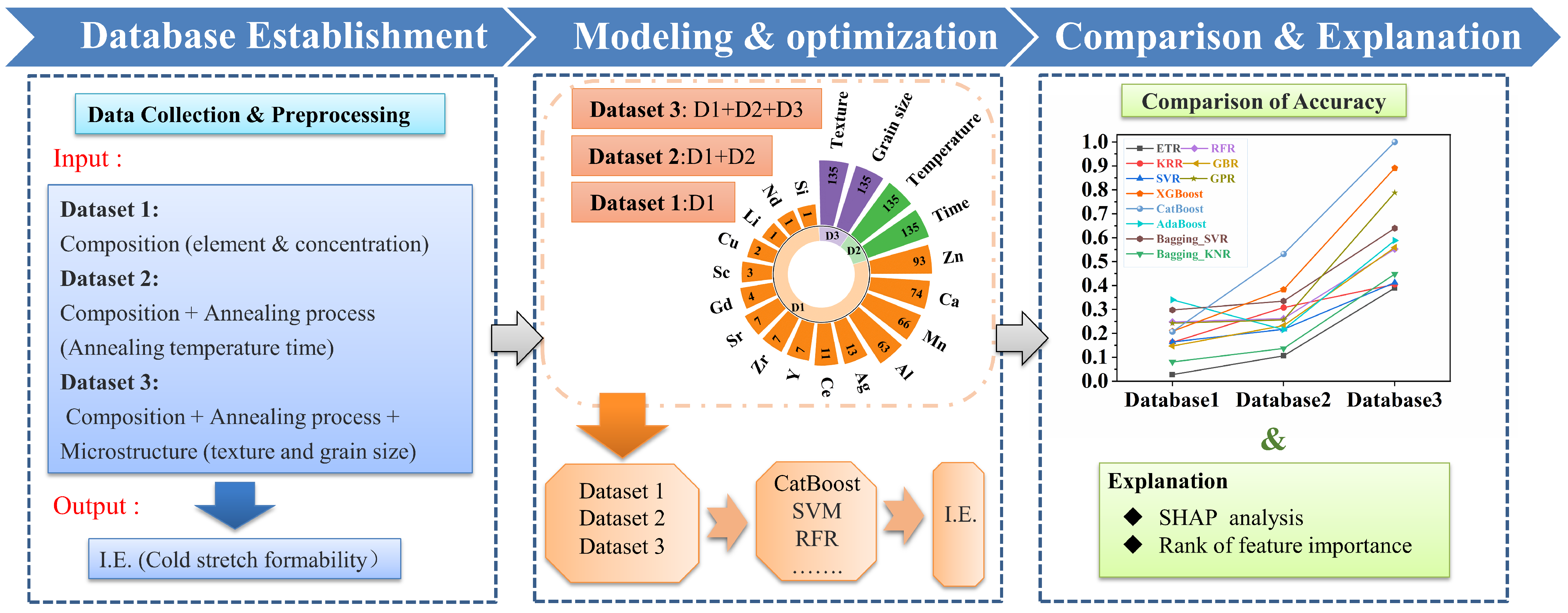
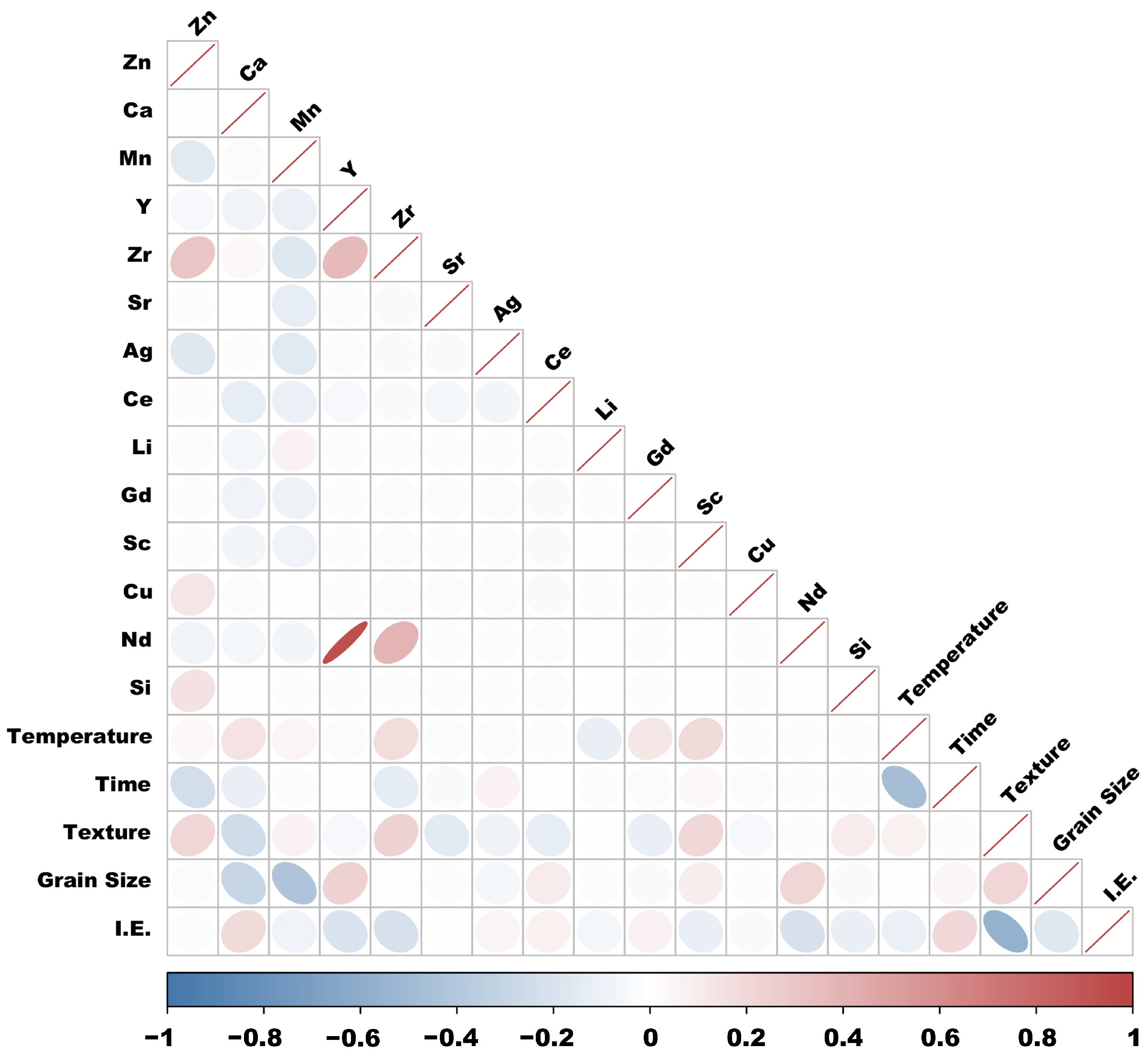
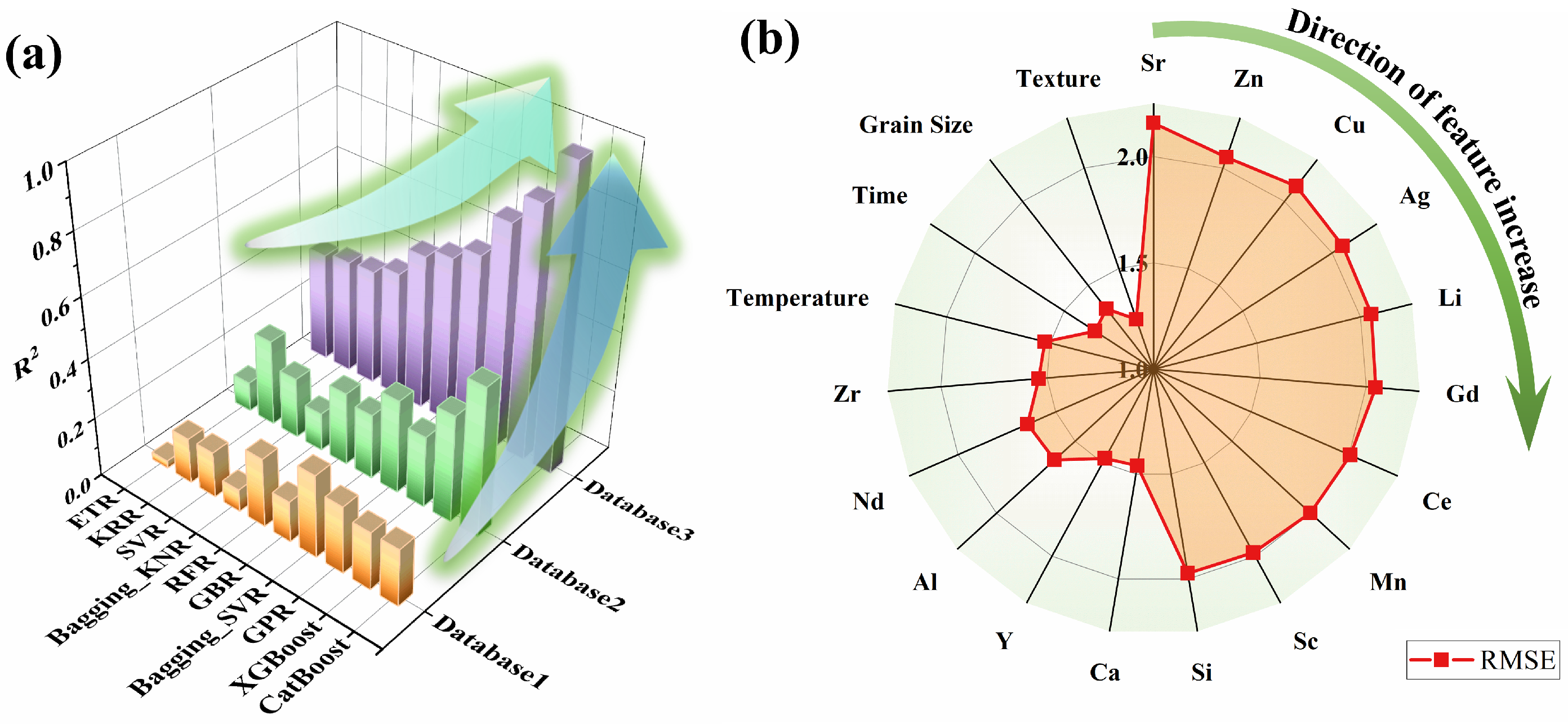
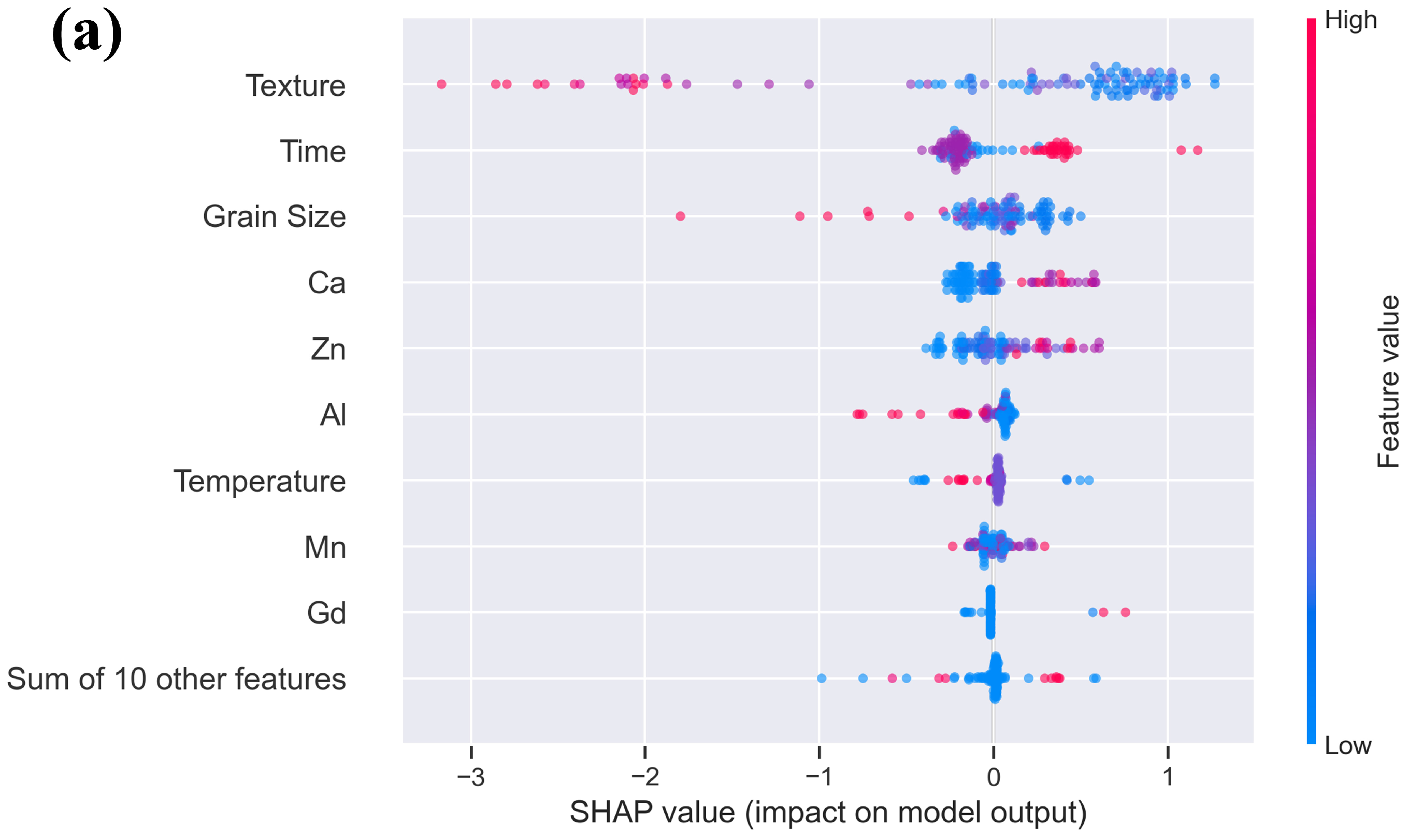
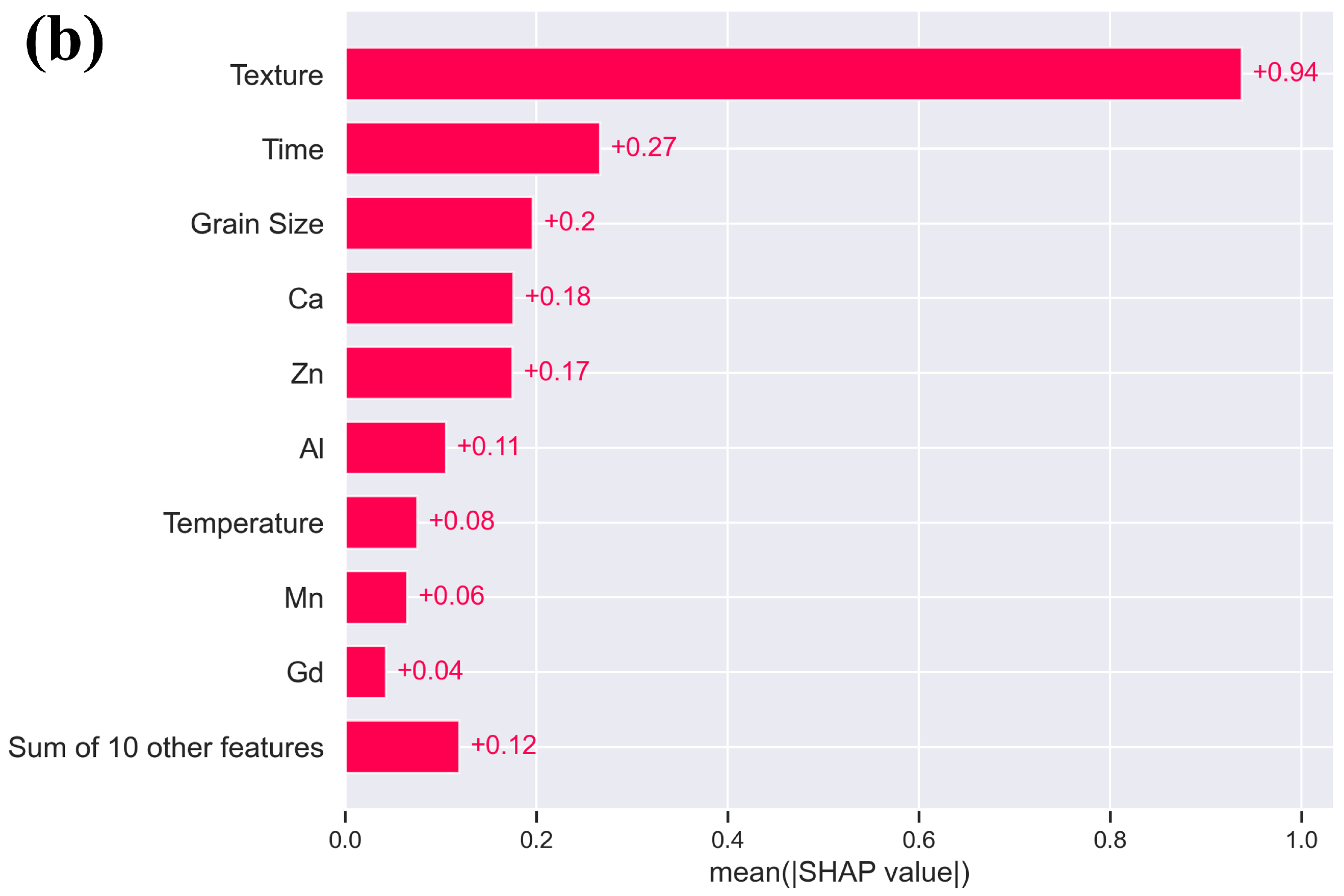
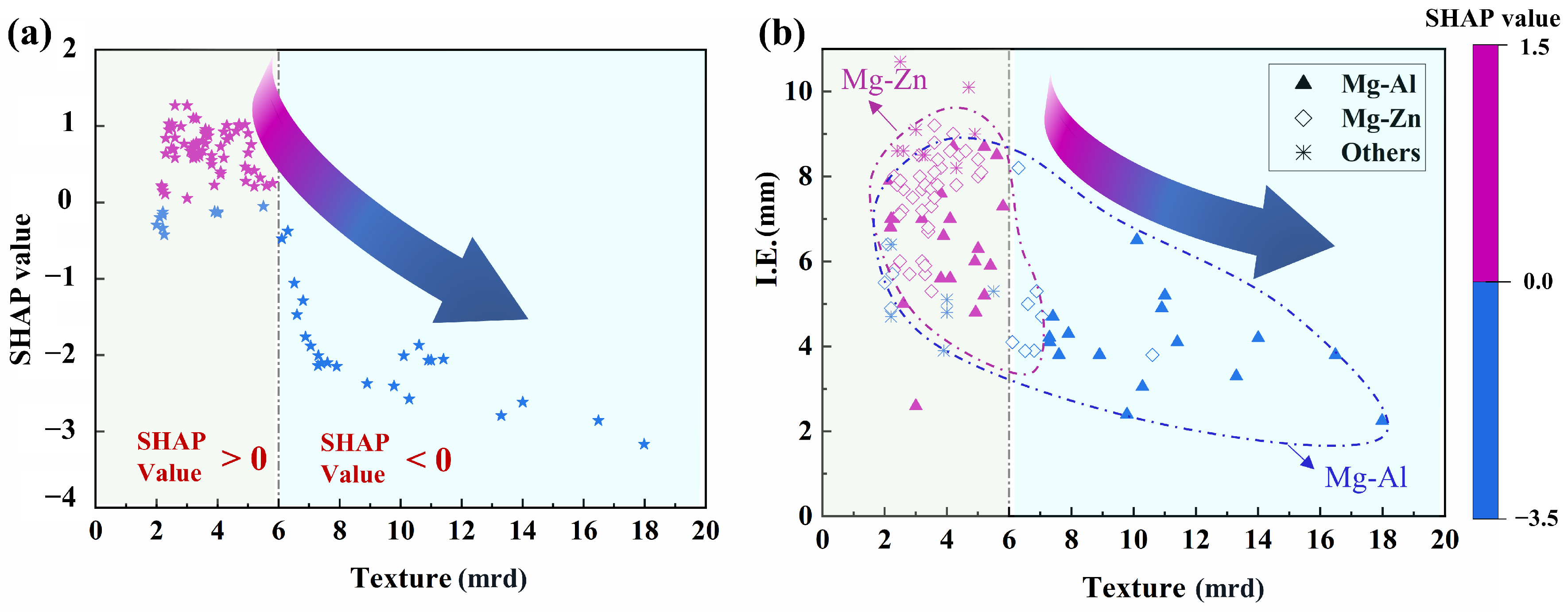
| Descriptor | Definition | Range |
|---|---|---|
| Compositions (wt%) | Al | 0–9.07 |
| Zn | 0–6.2 | |
| Ca | 0–2.1 | |
| Mn | 0–1.3 | |
| Y | 0–4.2 | |
| Zr | 0–0.5 | |
| Sr | 0–2 | |
| Ag | 0–11 | |
| Ce | 0–0.2 | |
| Li | 0–3 | |
| Gd | 0–2.74 | |
| Sc | 0–1.5 | |
| Cu | 0–0.31 | |
| Nd | 0–2.3 | |
| Si | 0–0.22 | |
| Annealing Process | Temperature (K) | 473–753 |
| Time (h) | 0.25–8 | |
| Microstructure | Grain size (um) | 5–63 |
| Texture (mrd) | 2–18.4 | |
| Stretch formability | Index Erichsen (mm) | 1.7–10.7 |
Disclaimer/Publisher’s Note: The statements, opinions and data contained in all publications are solely those of the individual author(s) and contributor(s) and not of MDPI and/or the editor(s). MDPI and/or the editor(s) disclaim responsibility for any injury to people or property resulting from any ideas, methods, instructions or products referred to in the content. |
© 2023 by the authors. Licensee MDPI, Basel, Switzerland. This article is an open access article distributed under the terms and conditions of the Creative Commons Attribution (CC BY) license (https://creativecommons.org/licenses/by/4.0/).
Share and Cite
Yang, J.; Shi, R.; Luo, A.A. Unveiling the Alloying-Processing-Microstructure Correlations in High-Formability Sheet Magnesium Alloys. Metals 2023, 13, 704. https://doi.org/10.3390/met13040704
Yang J, Shi R, Luo AA. Unveiling the Alloying-Processing-Microstructure Correlations in High-Formability Sheet Magnesium Alloys. Metals. 2023; 13(4):704. https://doi.org/10.3390/met13040704
Chicago/Turabian StyleYang, Jiyong, Renhai Shi, and Alan A. Luo. 2023. "Unveiling the Alloying-Processing-Microstructure Correlations in High-Formability Sheet Magnesium Alloys" Metals 13, no. 4: 704. https://doi.org/10.3390/met13040704
APA StyleYang, J., Shi, R., & Luo, A. A. (2023). Unveiling the Alloying-Processing-Microstructure Correlations in High-Formability Sheet Magnesium Alloys. Metals, 13(4), 704. https://doi.org/10.3390/met13040704







